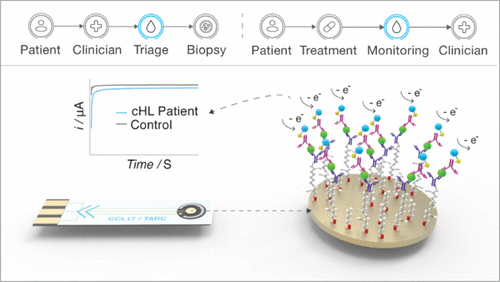Our official English website, www.x-mol.net, welcomes your
feedback! (Note: you will need to create a separate account there.)
Development of an Electrochemical CCL17/TARC Biosensor toward Rapid Triage and Monitoring of Classic Hodgkin Lymphoma
ACS Sensors ( IF 8.2 ) Pub Date : 2021-09-03 , DOI: 10.1021/acssensors.1c00972 Christopher Rinaldi 1 , Damion K Corrigan 2 , Lynn Dennany 1 , Ruth F Jarrett 3 , Annette Lake 3 , Matthew J Baker 4
ACS Sensors ( IF 8.2 ) Pub Date : 2021-09-03 , DOI: 10.1021/acssensors.1c00972 Christopher Rinaldi 1 , Damion K Corrigan 2 , Lynn Dennany 1 , Ruth F Jarrett 3 , Annette Lake 3 , Matthew J Baker 4
Affiliation

|
A point-of-care blood test for the detection of an emerging biomarker, CCL17/TARC, could prove transformative for the clinical management of classic Hodgkin lymphoma (cHL). Primary care diagnosis is challenging due to nonspecific clinical presentation and lack of a diagnostic test, leading to significant diagnostic delays. Treatment monitoring encounters false-positive and negative results, leading to avoidable chemotherapy toxicity, or undertreatment, impacting patient morbidity and mortality. Here, we present an amperometric CCL17/TARC immunosensor, based on the utilization of a thiolated heterobifunctional cross-linker and sandwich antibody assay, to facilitate novel primary care triage and chemotherapy monitoring strategies for cHL. The immunosensor shows excellent analytical performance for clinical testing; linearity (R2 = 0.986), detection limit (194 pg/mL), and lower and upper limits of quantitation (387–50 000 pg/mL). The biosensor differentiated all 42 newly diagnosed cHL patients from healthy volunteers, based on serum CCL17/TARC concentration, using blood samples collected prior to treatment intervention. The immunosensor also discriminated between paired blood samples of all seven cHL patients, respectively, collected prior to treatment and during chemotherapy, attributed to the decrease in serum CCL17/TARC concentration following chemotherapy response. Overall, we have shown, for the first time, the potential of an electrochemical CCL17/TARC biosensor for primary care triage and chemotherapy monitoring for cHL, which would have positive clinical and psychosocial implications for patients, while streamlining current healthcare pathways.
中文翻译:

开发用于快速分类和监测经典霍奇金淋巴瘤的电化学 CCL17/TARC 生物传感器
用于检测新兴生物标志物 CCL17/TARC 的即时血液检测可能证明对经典霍奇金淋巴瘤 (cHL) 的临床管理具有变革性意义。由于非特异性临床表现和缺乏诊断测试,初级保健诊断具有挑战性,导致严重的诊断延误。治疗监测会遇到假阳性和阴性结果,导致可避免的化疗毒性或治疗不足,从而影响患者的发病率和死亡率。在这里,我们提出了一种基于硫醇化异双功能交联剂和夹心抗体测定的电流型 CCL17/TARC 免疫传感器,以促进新的 cHL 初级保健分诊和化疗监测策略。免疫传感器在临床测试中表现出出色的分析性能;线性度(2 _= 0.986)、检测限 (194 pg/mL) 和定量下限和上限 (387–50 000 pg/mL)。该生物传感器使用治疗干预前采集的血液样本,根据血清 CCL17/TARC 浓度,将所有 42 名新诊断的 cHL 患者与健康志愿者区分开来。免疫传感器还分别在治疗前和化疗期间收集的所有 7 名 cHL 患者的配对血液样本之间进行区分,这归因于化疗反应后血清 CCL17/TARC 浓度的降低。总体而言,我们首次展示了电化学 CCL17/TARC 生物传感器在 cHL 初级保健分诊和化疗监测中的潜力,这将对患者产生积极的临床和心理社会影响,同时简化当前的医疗保健途径。
更新日期:2021-09-24
中文翻译:

开发用于快速分类和监测经典霍奇金淋巴瘤的电化学 CCL17/TARC 生物传感器
用于检测新兴生物标志物 CCL17/TARC 的即时血液检测可能证明对经典霍奇金淋巴瘤 (cHL) 的临床管理具有变革性意义。由于非特异性临床表现和缺乏诊断测试,初级保健诊断具有挑战性,导致严重的诊断延误。治疗监测会遇到假阳性和阴性结果,导致可避免的化疗毒性或治疗不足,从而影响患者的发病率和死亡率。在这里,我们提出了一种基于硫醇化异双功能交联剂和夹心抗体测定的电流型 CCL17/TARC 免疫传感器,以促进新的 cHL 初级保健分诊和化疗监测策略。免疫传感器在临床测试中表现出出色的分析性能;线性度(2 _= 0.986)、检测限 (194 pg/mL) 和定量下限和上限 (387–50 000 pg/mL)。该生物传感器使用治疗干预前采集的血液样本,根据血清 CCL17/TARC 浓度,将所有 42 名新诊断的 cHL 患者与健康志愿者区分开来。免疫传感器还分别在治疗前和化疗期间收集的所有 7 名 cHL 患者的配对血液样本之间进行区分,这归因于化疗反应后血清 CCL17/TARC 浓度的降低。总体而言,我们首次展示了电化学 CCL17/TARC 生物传感器在 cHL 初级保健分诊和化疗监测中的潜力,这将对患者产生积极的临床和心理社会影响,同时简化当前的医疗保健途径。











































 京公网安备 11010802027423号
京公网安备 11010802027423号